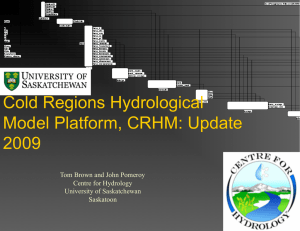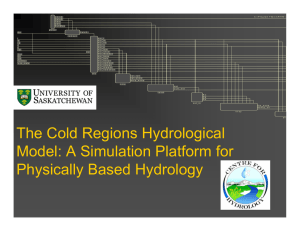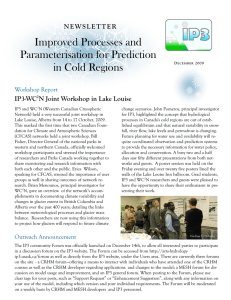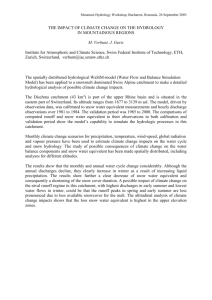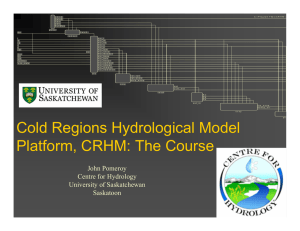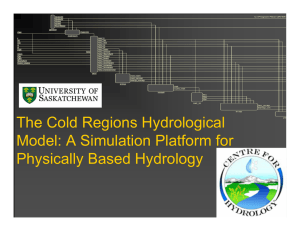The Cold Regions Hydrological Model (CRHM)
advertisement
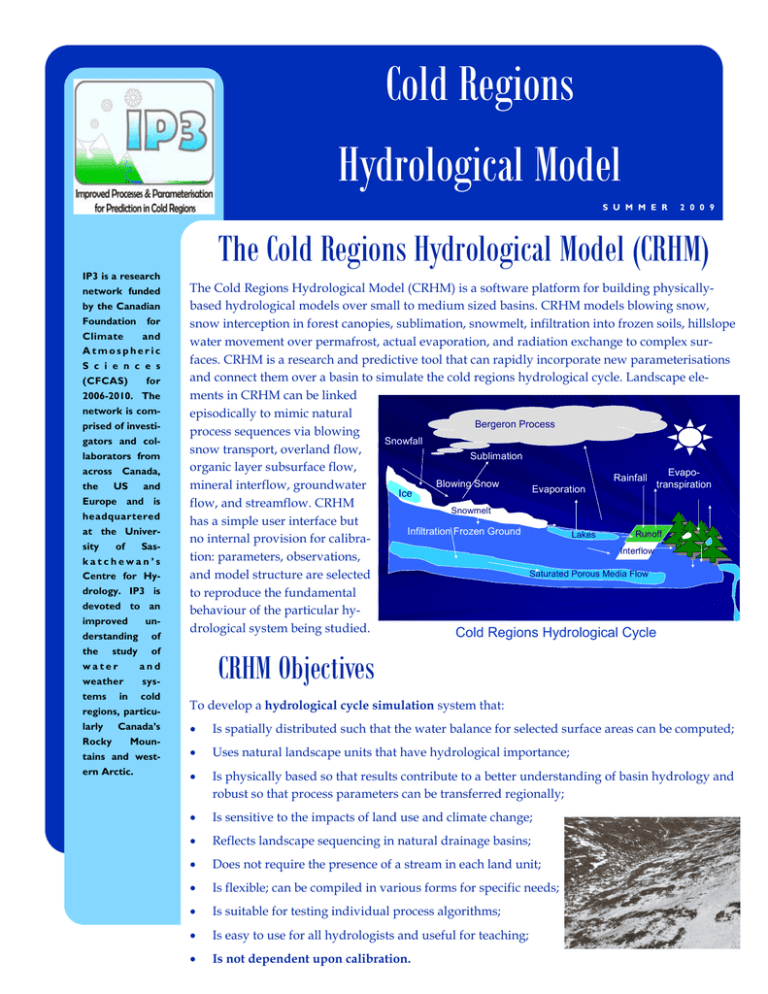
II II PP PP MM MM RR RR PP PP EE EE RR RR DD DD OO OO II II VV VV CC CC EE EE TT TT DD DD II II OO OO PP PP NN NN RR RR OO OO II II CC CC NN NN EE EE SS SS CC CC SS SS OO OO EE EE LL LL SS SS DD DD && && RR RR EE EE PP PP GG GG AA AA II II RR RR OO OO AA AA NN NN MM MM SS SS EE EE TT TT EE EE RR RR II II SS SS AA AA TT TT II II OO OO NN NN FF FF OO OO Cold Regions RR RR Hydrological Model S U M M E R 2 0 0 9 The Cold Regions Hydrological Model (CRHM) IP3 is a research network funded by the Canadian Foundation for Climate and Atmospheric S c i e n c e s (CFCAS) for 2006-2010. The network is comprised of investigators and collaborators from across Canada, the US and Europe and is headquartered at the University of Saskatchewan’s Centre for Hydrology. IP3 is devoted to an improved understanding of the study of water and weather systems in cold regions, particularly Canada’s Rocky Mountains and western Arctic. The Cold Regions Hydrological Model (CRHM) is a software platform for building physicallybased hydrological models over small to medium sized basins. CRHM models blowing snow, snow interception in forest canopies, sublimation, snowmelt, infiltration into frozen soils, hillslope water movement over permafrost, actual evaporation, and radiation exchange to complex surfaces. CRHM is a research and predictive tool that can rapidly incorporate new parameterisations and connect them over a basin to simulate the cold regions hydrological cycle. Landscape elements in CRHM can be linked episodically to mimic natural Bergeron Process process sequences via blowing Snowfall snow transport, overland flow, Sublimation organic layer subsurface flow, EvapoRainfall Blowing Snow transpiration mineral interflow, groundwater Evaporation Ice flow, and streamflow. CRHM Snowmelt has a simple user interface but Infiltration Frozen Ground Runoff Lakes no internal provision for calibraInterflow tion: parameters, observations, Saturated Porous Media Flow and model structure are selected to reproduce the fundamental behaviour of the particular hydrological system being studied. Cold Regions Hydrological Cycle CRHM Objectives To develop a hydrological cycle simulation system that: • Is spatially distributed such that the water balance for selected surface areas can be computed; • Uses natural landscape units that have hydrological importance; • Is physically based so that results contribute to a better understanding of basin hydrology and robust so that process parameters can be transferred regionally; • Is sensitive to the impacts of land use and climate change; • Reflects landscape sequencing in natural drainage basins; • Does not require the presence of a stream in each land unit; • Is flexible; can be compiled in various forms for specific needs; • Is suitable for testing individual process algorithms; • Is easy to use for all hydrologists and useful for teaching; • Is not dependent upon calibration. CRHM Modules and Structure The complete set of CRHM modules can be classified into the following categories: 1. Basin: Basin and hydrologic response unit (HRU) physical, soil, and vegetation characteristics (reference definition for HRU in specifications below) 2. Observation: Interpolates meteorological data to HRU using adiabatic relationships and saturation vapour pressure calculations 3. Snow Transport: Blowing snow transport and sublimation 4. Interception: Rainfall interception, snowfall interception, snow interception in forest canopies and sublimation 5. Radiation: Shortwave direct and diffuse algorithms, slope corrections, snow albedo decay, longwave radiation, canopy transmissivity and net radiation 6. Evaporation: Several physically-based methods for unsaturated and saturated surfaces including transpiration 7. Snowmelt: Energy balance snowmelt, radiation index, temperature index, snow cover depletion and simple land surface scheme melt methods 8. Infiltration: Basic and parametric infiltration routines for frozen soils, frost depth calculation, Green-Ampt infiltration and redistribution for unfrozen soils 9: Soil Moisture Balance: Multiple flowpath 2-layer “bucket” model with sub-surface flow, groundwater, depressional storage and “pond” options 10: Flow: Organic layer flow, timing and storage control of overland flow, mineral interflow, and streamflow, using the lag and route hydrograph and Muskingum routing methods CRHM Specifications The CRHM interface consists of a native Microsoft Windows application written in C++ that can be run in XP, Vista, Linux and the Macintosh environment. The data are plotted as the model runs, and the results can either be exported to a text file, ArcGIS, or an EXCEL spreadsheet. The exported data can then be taken into other programs which are used for post-processing of the data, or the data can be used to drive other models. CRHM can be run in either spatially-distributed or aggregated modes to show the effect of differing model resolution. The basic unit of calculation in the model is the HRU (Hydrologic Response Unit), which is a spatial unit represented in the basin through three groups of attributes: John Pomeroy Principal Investigator john.pomeroy@usask.ca Biophysical structure: soils, vegetation, slope, elevation and area 403-609-3809 Hydrological state: snow water equivalent, snow internal energy, intercepted snow load, soil moisture and water table Nadine Kapphahn Hydrological flux: snow transport, sublimation, evaporation, melt discharge, infiltration, drainage and runoff CRHM was developed and coded by Modeller Tom Brown based at the University of Saskatchewan’s Centre for Hydrology. To learn more about IP3 and CRHM visit our website at http://www.usask.ca/ip3/ Outreach Coordinator nadine.kapphahn@usask.ca 250-960-5898
